Assessment of Forest Fire Impact and Vegetation Recovery in the Ghalahmah Mountains, Saudi Arabia
Abstract
1. Introduction
2. Materials and Methods
2.1. Study Area
2.2. Overall Methodology
2.3. Data Used
2.4. Relativized Burn Ratio
2.4.1. Normalized Burn Ratio (NBR)
2.4.2. Differenced Normalized Burn Ratio (dNBR)
2.4.3. Relativized Burn Ratio (RBR)
2.5. Relationship Between Differenced Normalized Burn Ratio (dNBR) and Pre-Fire Environmental Factors
2.5.1. Correlation Analysis
2.5.2. Random Forest Regression Model
2.6. Forest Fire Recovery Rate
2.6.1. Normalized Difference Vegetation Index (NDVI)
2.6.2. Recovery Rate
2.6.3. Recovery Classification
3. Results
3.1. Forest Fire Severity and Extent
3.2. Feature Importance Analysis
3.3. Vegetation Recovery
4. Discussion
5. Conclusions
Author Contributions
Funding
Institutional Review Board Statement
Informed Consent Statement
Data Availability Statement
Acknowledgments
Conflicts of Interest
Abbreviation
| AMSL | Above Mean Sea Level |
| DEM | Digital Elevation Model |
| dNBR | Differenced Normalized Burn Ratio |
| FCC | False Color Composite |
| LST | Land Surface Temperature |
| NDVI | Normalized Difference Vegetation Index |
| NDWI | Normalized Difference Water Index |
| NBR | Normalized Burn Ratio |
| NIR | Near-Infrared |
| RBR | Relativized Burn Ratio |
| SWIR | Shortwave Infrared |
| VIIRS | Visible Infrared Imaging Radiometer Suite |
| WRS-2 | Worldwide Reference System-2 |
| MSE | Mean Squared Error |
| %IncMSE | Percentage Increase in Mean Squared Error |
| Landsat 8 OLI/TIRS | Landsat 8 Operational Land Imager/Thermal Infrared Sensor |
| Sentinel-2 SR | Sentinel-2 Surface Reflectance |
| NDVI | Normalized Difference Vegetation Index |
| NDWI | Normalized Difference Water Index |
| LST | Land Surface Temperature |
References
- Wu, Z.; Li, M.; Wang, B.; Tian, Y.; Quan, Y.; Liu, J. Analysis of Factors Related to Forest Fires in Different Forest Ecosystems in China. Forests 2022, 13, 1021. [Google Scholar] [CrossRef]
- GFW Global Deforestation Rates & Statistics by Country|GFW. Available online: https://www.globalforestwatch.org/dashboards/global/?category=fires (accessed on 17 February 2025).
- El-Rawy, M.; Batelaan, O.; Al-Arifi, N.; Alotaibi, A.; Abdalla, F.; Gabr, M.E. Climate Change Impacts on Water Resources in Arid and Semi-Arid Regions: A Case Study in Saudi Arabia. Water 2023, 15, 606. [Google Scholar] [CrossRef]
- Bayoumi, S.; Alghamdi, K.; Alqusair, D.; Alfutamani, A. Visualization of Fire Accidents in Saudi Arabia. In Proceedings of the 2018 21st Saudi Computer Society National Computer Conference (NCC), Riyadh, Saudi Arabia, 25–26 April 2018; Volume 90, pp. 1–6. [Google Scholar] [CrossRef]
- Brooks, W.H.; Mandil, K.S.D. Vegetation Dynamics in the Aseer Woodlands of South-Western Saudi Arabia. J. Arid. Environ. 1983, 6, 357–362. [Google Scholar] [CrossRef]
- Al-Qthanin, R.; Al-Rumman, W.; Radwan, A. Impact of Forest Fires on Wood Anatomy, Soil Composition, and Soil Microorganisms of Acacia Origena Asfaw (Leguminosae) in al Souda Mountain, Southwestern Saudi Arabia. Egypt. J. Agron. 2024, 46, 29–37. [Google Scholar] [CrossRef]
- Pausas, J.G.; Keeley, J.E. Wildfires as an ecosystem service. Front. Ecol. Environ. 2019, 17, 289–295. [Google Scholar] [CrossRef]
- Johnstone, J.F.; Allen, C.D.; Franklin, J.F.; Frelich, L.E.; Harvey, B.J.; Higuera, P.E.; Mack, M.C.; Meentemeyer, R.K.; Metz, M.R.; Perry, G.L.W.; et al. Changing disturbance regimes, ecological memory, and forest resilience. Front. Ecol. Environ. 2016, 14, 369–378. [Google Scholar] [CrossRef]
- Meng, R.; Dennison, P.E.; D’Antonio, C.M.; Moritz, M.A. Remote sensing analysis of vegetation recovery following short-interval fires in southern California shrublands. PLoS ONE 2014, 9, e110637. [Google Scholar] [CrossRef] [PubMed]
- Key, C.H.; Benson, N.C. Landscape assessment: Remote sensing of severity, the Normalized Burn Ratio. In FIREMON: Fire Effects Monitoring and Inventory System; USDA Forest Service: Fort Collins, CO, USA, 2006. [Google Scholar] [CrossRef]
- Parks, S.A.; Dillon, G.K.; Miller, C. A new metric for quantifying burn severity: The Relativized Burn Ratio. Remote Sens. 2014, 6, 1827–1844. [Google Scholar] [CrossRef]
- GFW `Aseer, Saudi Arabia Deforestation Rates & Statistics|GFW. Available online: https://www.globalforestwatch.org/dashboards/country/SAU/1/?category=fires (accessed on 17 February 2025).
- Mohammad, A. Impact of Anthropogenic Activities on Natural Vegetation Cover of Aseer Region, Saudi Arabia. Egypt. J. Environ. Change Egypt. J. Environ. Change 2021, 13, 33–50. [Google Scholar] [CrossRef]
- Agbeshie, A.A.; Abugre, S.; Atta-Darkwa, T.; Awuah, R. A Review of the Effects of Forest Fire on Soil Properties. J. For. Res. 2022, 33, 1419–1441. [Google Scholar] [CrossRef]
- Villaverde Canosa, I.; Ford, J.; Paavola, J.; Burnasheva, D. Community Risk and Resilience to Wildfires: Rethinking the Complex Human–Climate–Fire Relationship in High-Latitude Regions. Sustainability 2024, 16, 957. [Google Scholar] [CrossRef]
- Kala, C.P. Environmental and Socioeconomic Impacts of Forest Fires: A Call for Multilateral Cooperation and Management Interventions. Nat. Hazards Res. 2023, 3, 286–294. [Google Scholar] [CrossRef]
- Helmi, A.M.; Farouk, M.I.; Hassan, R.; Mumtaz, M.A.; Chaouachi, L.; Elgamal, M.H. Comparing Remote Sensing and Geostatistical Techniques in Filling Gaps in Rain Gauge Records and Generating Multi-Return Period Isohyetal Maps in Arid Regions—Case Study: Kingdom of Saudi Arabia. Water 2024, 16, 925. [Google Scholar] [CrossRef]
- Hasanean, H.; Almazroui, M. Rainfall: Features and Variations over Saudi Arabia, A Review. Climate 2015, 3, 578–626. [Google Scholar] [CrossRef]
- USGS. Landsat 8 Operational Land Imager (OLI) and Thermal Infrared Sensor (TIRS). U.S. Geological Survey. Available online: https://www.usgs.gov/landsat-missions/landsat-8 (accessed on 18 December 2024).
- European Space Agency (ESA). Sentinel-2 User Handbook. ESA Standard Document. Available online: https://sentinels.copernicus.eu/web/sentinel/user-guides/sentinel-2-msi (accessed on 18 December 2024).
- Alcaras, E.; Costantino, D.; Guastaferro, F.; Parente, C.; Pepe, M. Normalized Burn Ratio Plus (NBR+): A New Index for Sentinel-2 Imagery. Remote Sens. 2022, 14, 1727. [Google Scholar] [CrossRef]
- Laonamsai, J.; Julphunthong, P.; Saprathet, T.; Kimmany, B.; Ganchanasuragit, T.; Chomcheawchan, P.; Tomun, N. Utilizing NDWI, MNDWI, SAVI, WRI, and AWEI for Estimating Erosion and Deposition in Ping River in Thailand. Hydrology 2023, 10, 70. [Google Scholar] [CrossRef]
- Ahmed, M.; Aloshan, M.A.; Mohammed, W.; Mesbah, E.; Alsaleh, N.A.; Elghonaimy, I. Characterizing Land Surface Temperature (LST) through Remote Sensing Data for Small-Scale Urban Development Projects in the Gulf Cooperation Council (GCC). Sustainability 2024, 16, 3873. [Google Scholar] [CrossRef]
- Netsianda, A.; Mhangara, P.; Gidey, E. Grassland Biome Fragmentation Analysis Using Sentinal-2 Images and Support Vector Machine Learning Model in South Africa. Discov. Sustain. 2024, 5, 455. [Google Scholar] [CrossRef]
- European Space Agency (ESA). Copernicus DEM—Global and Regional Digital Elevation Models. Available online: https://dataspace.copernicus.eu/explore-data/data-collections/copernicus-contributing-missions/collections-description/COP-DEM (accessed on 18 December 2024).
- Wu, Q. Geemap: A Python Package for Interactive Mapping with Google Earth Engine. J. Open Source Softw. 2020, 5, 2305. [Google Scholar] [CrossRef]
- Delcourt, C.J.F.; Combee, A.; Izbicki, B.; Mack, M.C.; Maximov, T.; Petrov, R.; Rogers, B.M.; Scholten, R.C.; Shestakova, T.A.; van Wees, D.; et al. Evaluating the Differenced Normalized Burn Ratio for Assessing Fire Severity Using Sentinel-2 Imagery in Northeast Siberian Larch Forests. Remote Sens. 2021, 13, 2311. [Google Scholar] [CrossRef]
- Szpakowski, D.M.; Jensen, J.L.R.; Chow, T.E.; Butler, D.R. Assessing the Use of Burn Ratios and Red-Edge Spectral Indices for Detecting Fire Effects in the Greater Yellowstone Ecosystem. Forests 2023, 14, 1508. [Google Scholar] [CrossRef]
- Pearson, K. Notes on Regression and Inheritance in the Case of Two Parents. Proc. R. Soc. Lond. 1895, 58, 240–242. [Google Scholar]
- Breiman, L. Random Forests. Mach. Learn. 2001, 45, 5–32. [Google Scholar] [CrossRef]
- Pettorelli, N.; Vik, J.O.; Mysterud, A.; Gaillard, J.M.; Tucker, C.J.; Stenseth, N.C. Using the satellite-derived NDVI to assess ecological responses to environmental change. Trends Ecol. Evol. 2005, 20, 503–510. [Google Scholar] [CrossRef] [PubMed]
- Bolan, S.; Sharma, S.; Mukherjee, S.; Isaza, D.F.G.; Rodgers, E.M.; Zhou, P.; Hou, D.; Scordo, F.; Chandra, S.; Siddique, K.H.M.; et al. Wildfires under Changing Climate, and Their Environmental and Health Impacts. J. Soils Sediments 2025, 8, 1–25. [Google Scholar] [CrossRef]
- Lee, K.; van Leeuwen, W.J.D.; Gillan, J.K.; Falk, D.A. Examining the Impacts of Pre-Fire Forest Conditions on Burn Severity Using Multiple Remote Sensing Platforms. Remote Sens. 2024, 16, 1803. [Google Scholar] [CrossRef]
- Morante-Carballo, F.; Bravo-Montero, L.; Carrión-Mero, P.; Velastegui-Montoya, A.; Berrezueta, E. Forest Fire Assessment Using Remote Sensing to Support the Development of an Action Plan Proposal in Ecuador. Remote Sens. 2022, 14, 1783. [Google Scholar] [CrossRef]
- Shan, Y.; Chen, X.; Yin, S.; Cao, L.; Tang, S.; Yu, B.; Cui, C. Study on the Limit of Moisture Content of the Sub-Surface Fires Converted to the Surface Fires in the Boreal Forests of China. Fire 2023, 6, 364. [Google Scholar] [CrossRef]
- Kong, J.; Ding, Z.; Cai, W.; Zu, J.; Liu, B.; Yang, J. Topography and Wildfire Jointly Mediate Postfire Ecosystem Multifunctionality in a Chinese Boreal Forest. Fire 2024, 7, 417. [Google Scholar] [CrossRef]
- Kalantar, B.; Ueda, N.; Idrees, M.O.; Janizadeh, S.; Ahmadi, K.; Shabani, F. Forest Fire Susceptibility Prediction Based on Machine Learning Models with Resampling Algorithms on Remote Sensing Data. Remote Sens. 2020, 12, 3682. [Google Scholar] [CrossRef]
- Jodhani, K.H.; Patel, H.; Soni, U.; Patel, R.; Valodara, B.; Gupta, N.; Patel, A.; Omar, P.J. Assessment of Forest Fire Severity and Land Surface Temperature Using Google Earth Engine: A Case Study of Gujarat State, India. Fire Ecol. 2024, 20, 23. [Google Scholar] [CrossRef]
- Pompa-García, M.; Martínez-Rivas, J.A.; Valdez-Cepeda, R.D.; Aguirre-Salado, C.A.; Rodríguez-Trejo, D.A.; Miranda-Aragón, L.; Rodríguez-Flores, F.d.J.; Vega-Nieva, D.J. NDVI Values Suggest Immediate Responses to Fire in an Uneven-Aged Mixed Forest Stand. Forests 2022, 13, 1901. [Google Scholar] [CrossRef]
- Maxwald, M.; Immitzer, M.; Rauch, H.P.; Preti, F. Analyzing Fire Severity and Post-Fire Vegetation Recovery in the Temperate Andes Using Earth Observation Data. Fire 2022, 5, 211. [Google Scholar] [CrossRef]
- Meneses, B.M. Vegetation Recovery Patterns in Burned Areas Assessed with Landsat 8 OLI Imagery and Environmental Biophysical Data. Fire 2021, 4, 76. [Google Scholar] [CrossRef]
- Hao, B.; Xu, X.; Wu, F.; Tan, L. Long-Term Effects of Fire Severity and Climatic Factors on Post-Forest-Fire Vegetation Recovery. Forests 2022, 13, 883. [Google Scholar] [CrossRef]
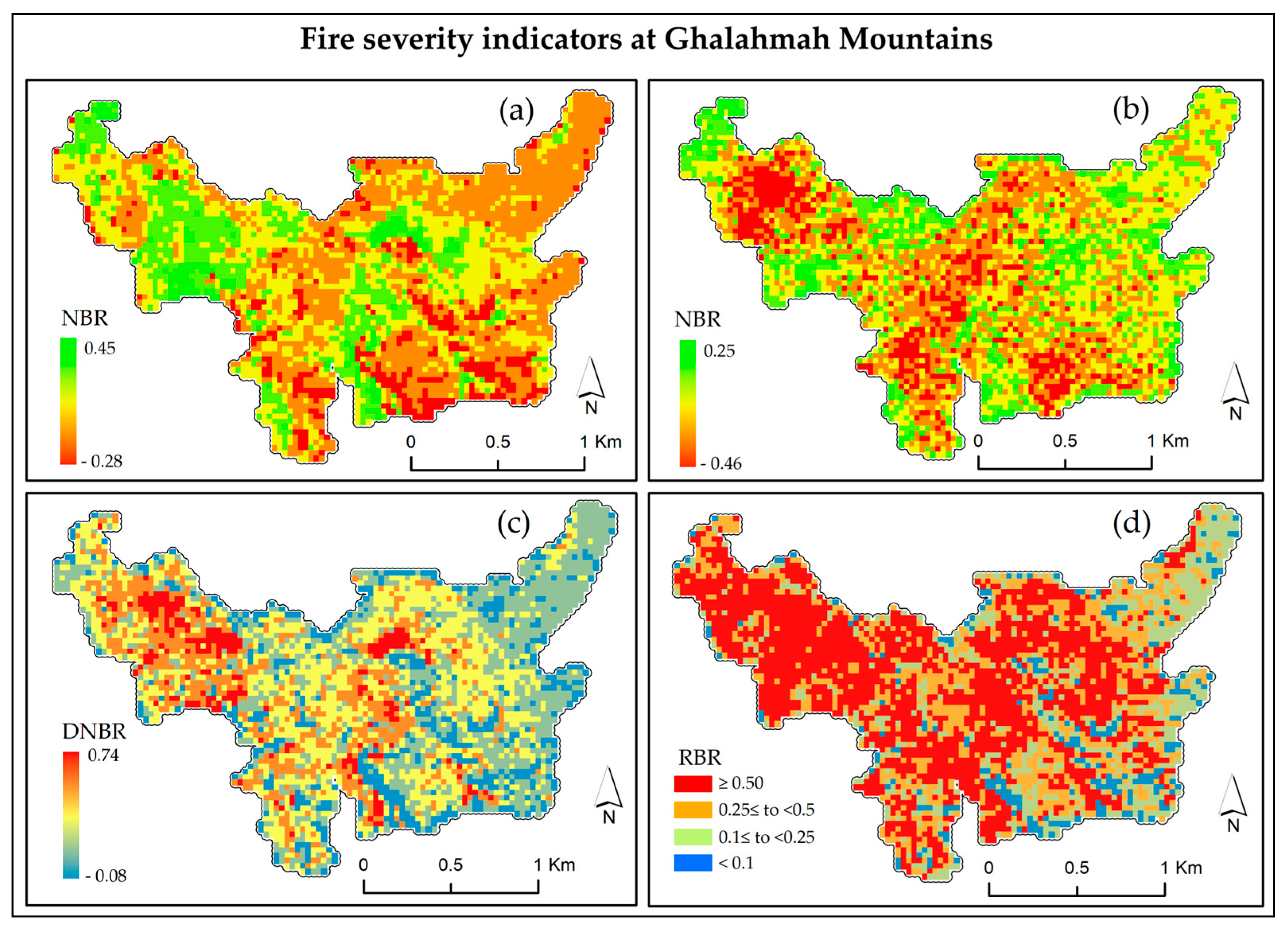
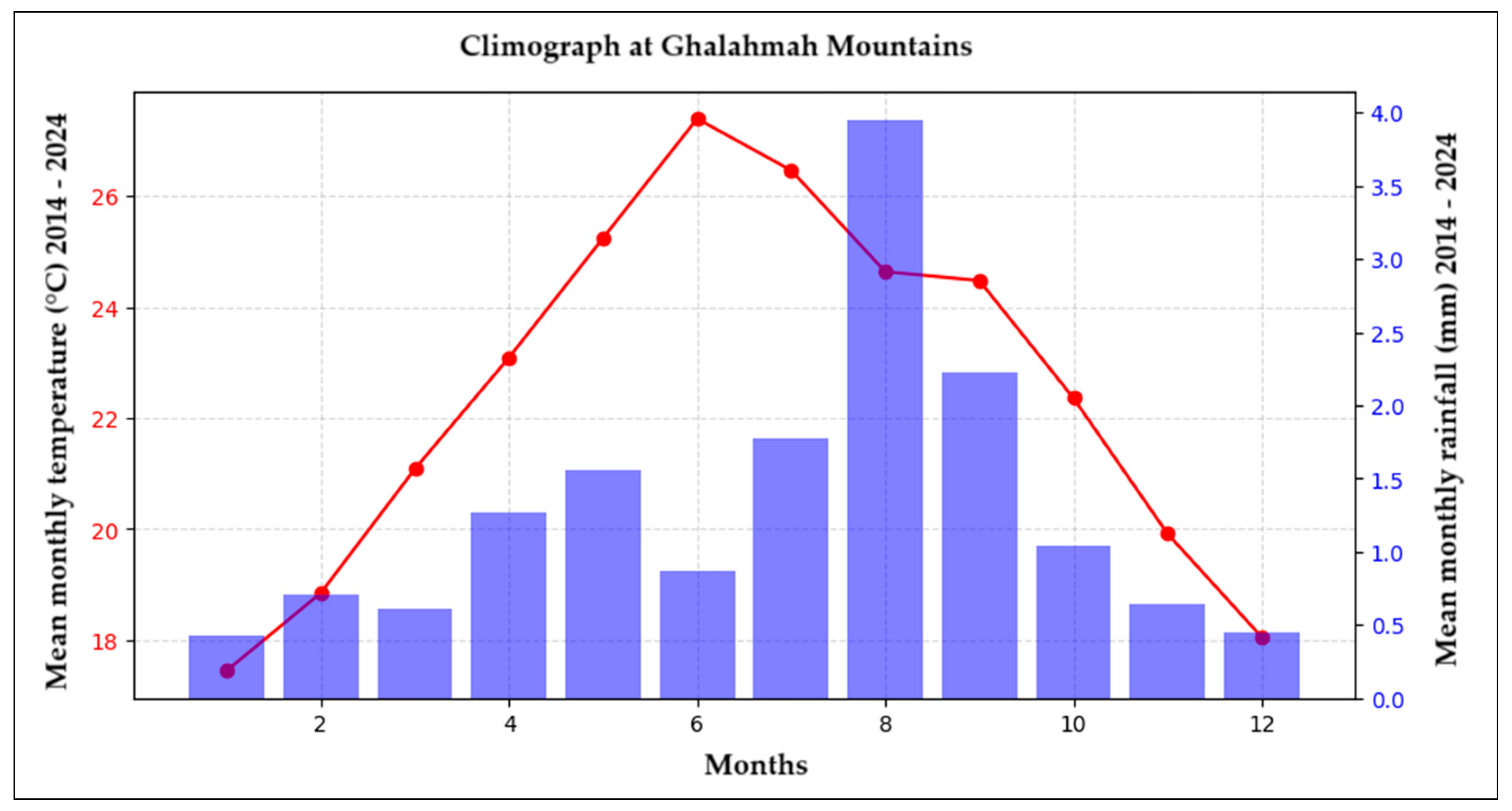
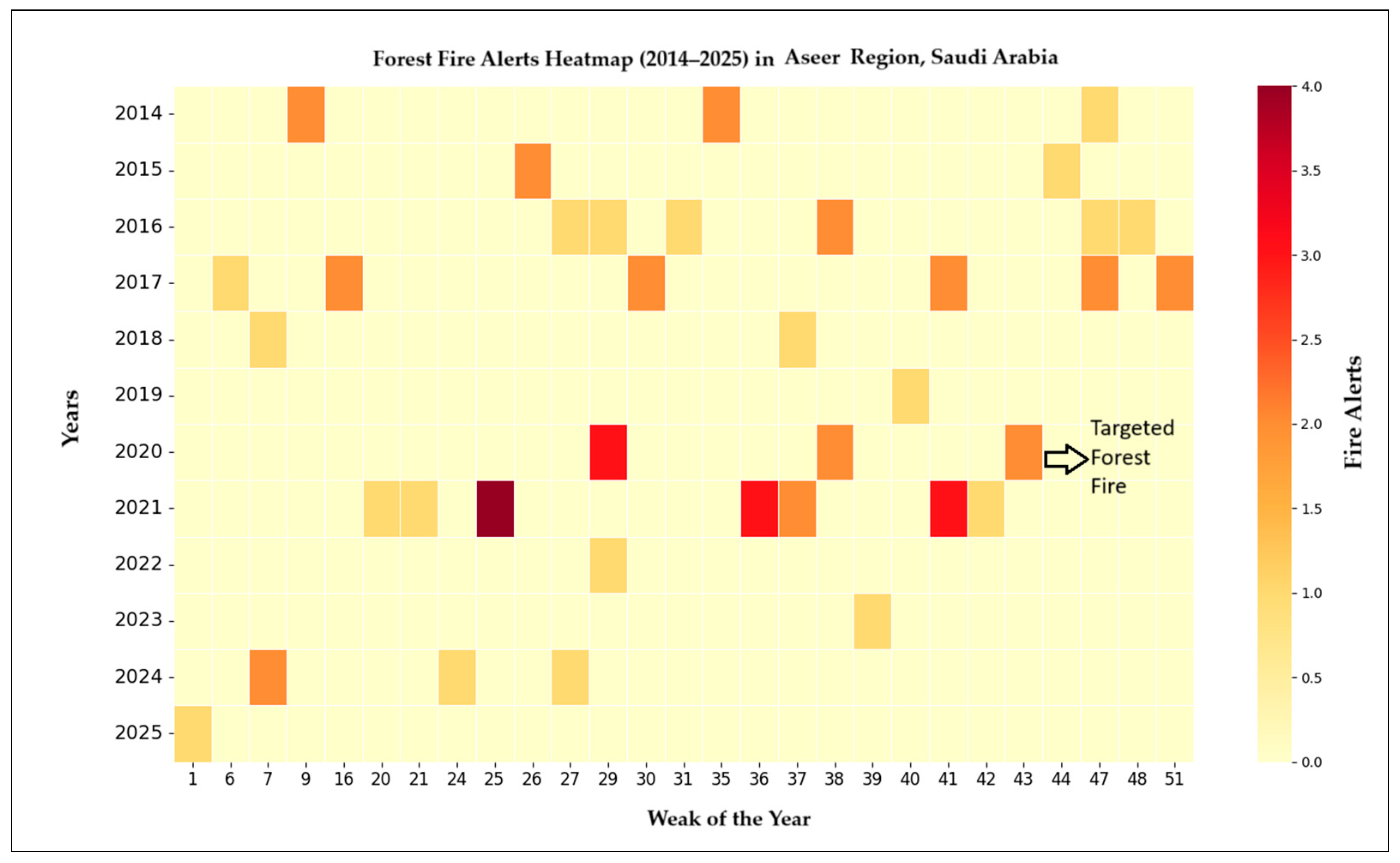
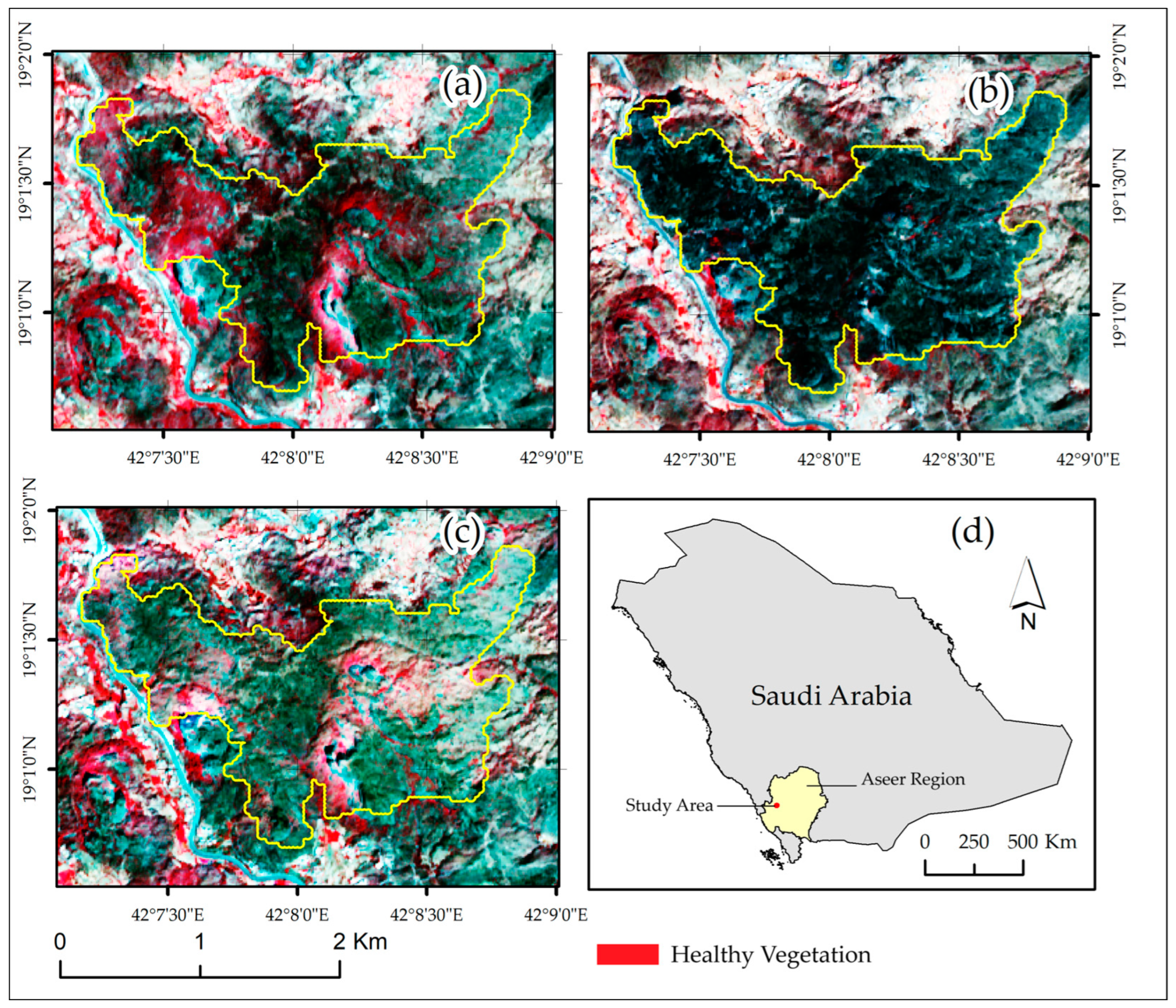
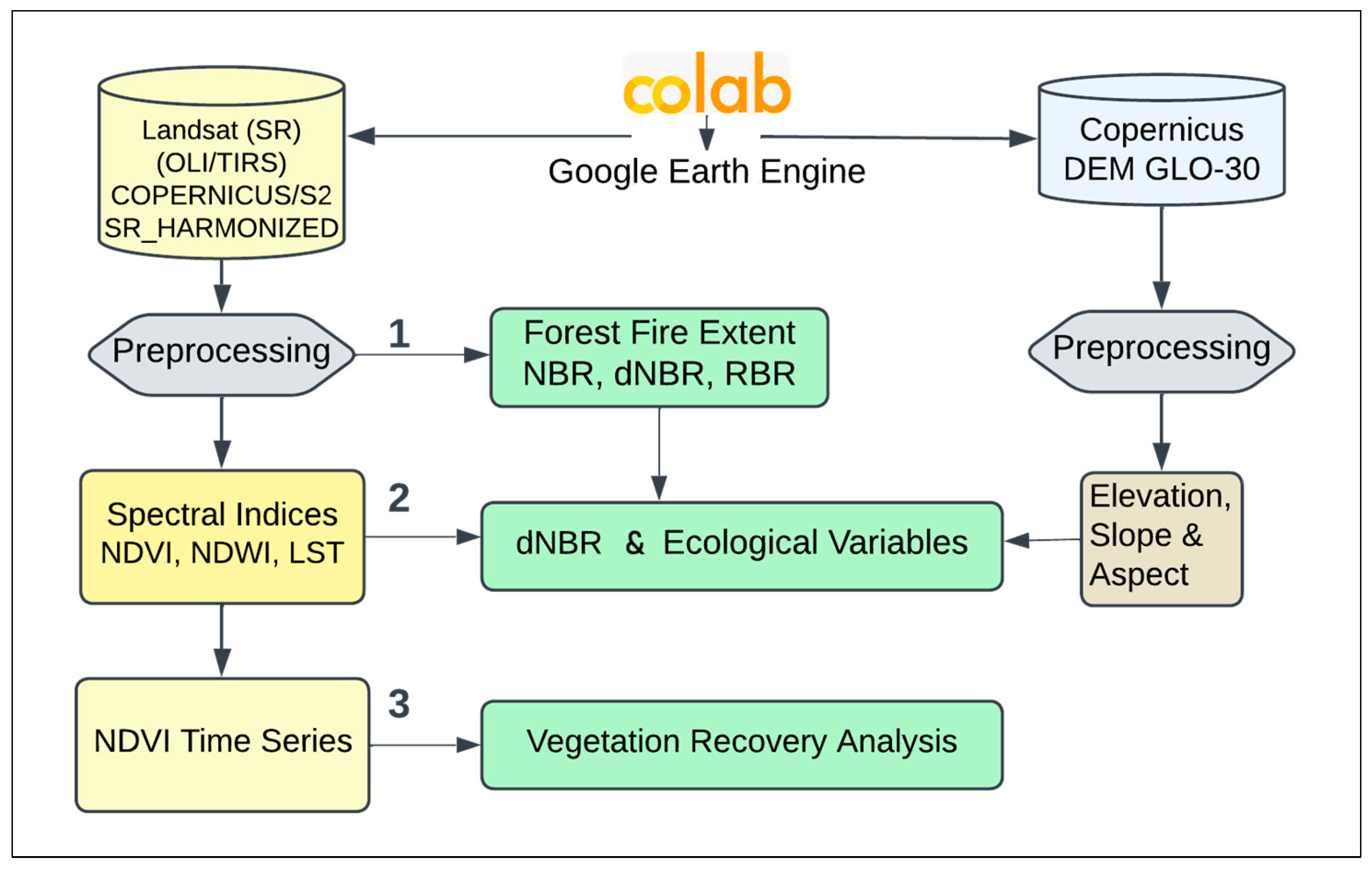
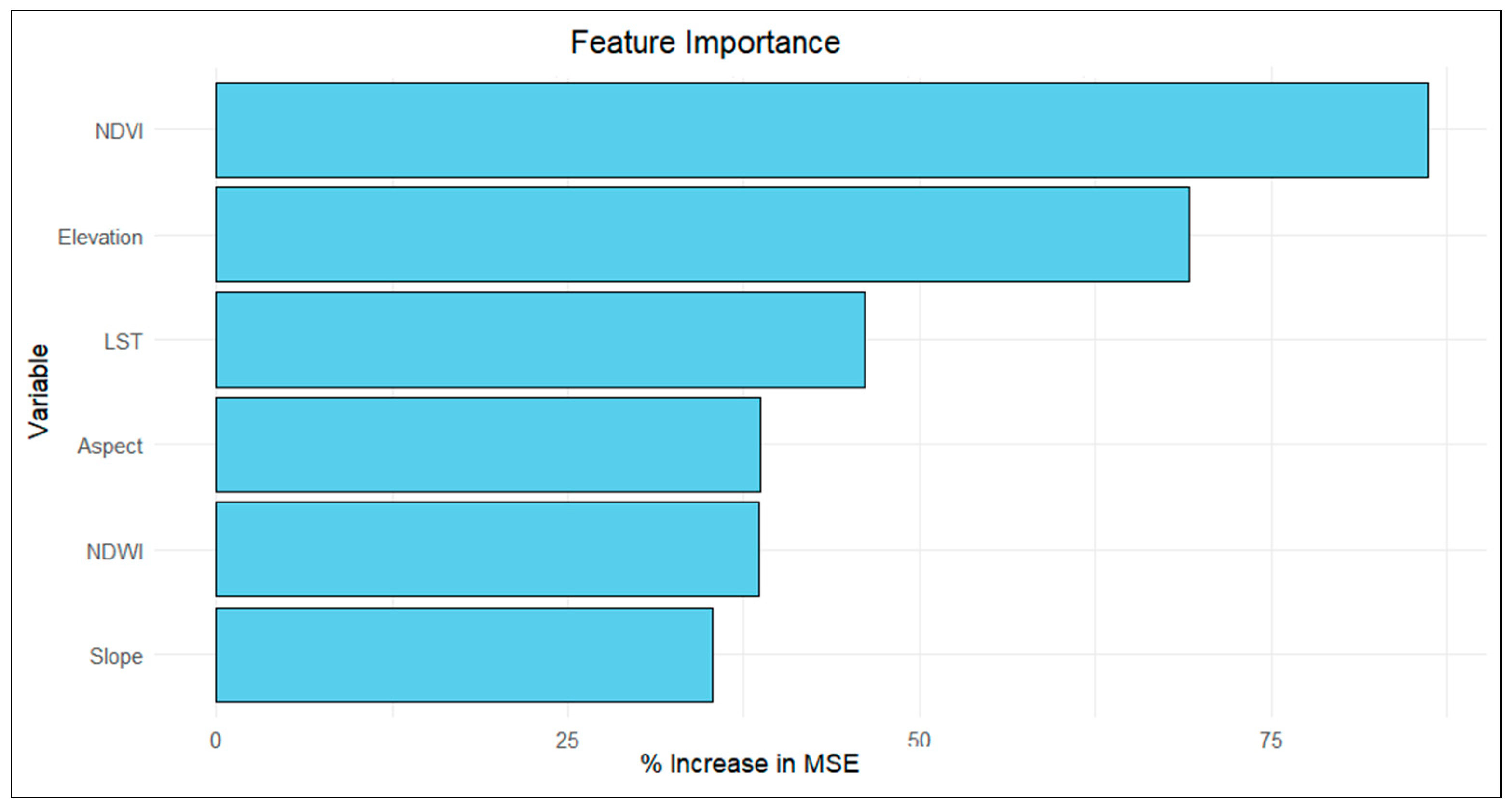

| Dataset(s) | Time Period | Purpose |
|---|---|---|
| Landsat 8 OLI/TIRS | 2020–2024 | NBR [21], NDWI [22], LST [23] |
| Copernicus/S2_SR_Harmonized | 2020–2024 | NDVI [24] |
| Copernicus/DEM/GLO30 | 2015 | 3D Analysis [25] |
| Severity Level | RBR Range | Description |
|---|---|---|
| Unburned | RBR < 0.1 | Minimal to no fire impact |
| Low Severity | 0.1 ≤ RBR < 0.250 | Some vegetation damage but minimal soil impact |
| Moderate Severity | 0.25 ≤ RBR < 0.50 | Significant vegetation damage and moderate impact on soil |
| High Severity | RBR ≥ 0.5 | Severe vegetation and soil damage, complete canopy burn |
| Variable | %IncMSE | IncNodePurity |
|---|---|---|
| NDVI | 86.10 | 14.95 |
| Elevation | 69.19 | 4.93 |
| LST | 46.14 | 4.99 |
| NDWI | 38.56 | 9.51 |
| Aspect | 38.67 | 2.57 |
| Slope | 35.29 | 4.17 |
| Vegetation Type | Recovery Type | 2021 | 2022 | 2023 | 2024 |
|---|---|---|---|---|---|
| High (NDVI > 0.3) | Still Recovering | 6.93 | 29.88 | 32.76 | 26.55 |
| Exceeded Pre-fire Condition | 3.51 | 4.50 | 17.73 | 25.29 | |
| Further Degradation | 44.82 | 20.88 | 4.77 | 3.42 | |
| Medium (NDVI 0.2 to 0.3) | Still Recovering | 88.92 | 125.91 | 43.2 | 27.18 |
| Exceeded Pre-fire Condition | 2.70 | 9.18 | 118.08 | 134.46 | |
| Further Degradation | 73.08 | 29.61 | 3.42 | 3.06 | |
| Low to Nil (NDVI < 0.2) | Still Recovering | 91.53 | 89.37 | 5.40 | 2.43 |
| Exceeded Pre-fire Condition | 5.04 | 9.54 | 101.16 | 103.59 | |
| Further Degradation | 11.25 | 8.91 | 1.26 | 1.80 |
Disclaimer/Publisher’s Note: The statements, opinions and data contained in all publications are solely those of the individual author(s) and contributor(s) and not of MDPI and/or the editor(s). MDPI and/or the editor(s) disclaim responsibility for any injury to people or property resulting from any ideas, methods, instructions or products referred to in the content. |
© 2025 by the authors. Licensee MDPI, Basel, Switzerland. This article is an open access article distributed under the terms and conditions of the Creative Commons Attribution (CC BY) license (https://creativecommons.org/licenses/by/4.0/).
Share and Cite
Al-Qthanin, R.; Aseeri, R. Assessment of Forest Fire Impact and Vegetation Recovery in the Ghalahmah Mountains, Saudi Arabia. Fire 2025, 8, 172. https://doi.org/10.3390/fire8050172
Al-Qthanin R, Aseeri R. Assessment of Forest Fire Impact and Vegetation Recovery in the Ghalahmah Mountains, Saudi Arabia. Fire. 2025; 8(5):172. https://doi.org/10.3390/fire8050172
Chicago/Turabian StyleAl-Qthanin, Rahmah, and Rahaf Aseeri. 2025. "Assessment of Forest Fire Impact and Vegetation Recovery in the Ghalahmah Mountains, Saudi Arabia" Fire 8, no. 5: 172. https://doi.org/10.3390/fire8050172
APA StyleAl-Qthanin, R., & Aseeri, R. (2025). Assessment of Forest Fire Impact and Vegetation Recovery in the Ghalahmah Mountains, Saudi Arabia. Fire, 8(5), 172. https://doi.org/10.3390/fire8050172






